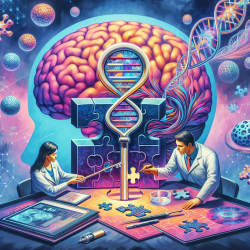Introduction
In the ever-evolving field of speech-language pathology, staying informed about the latest research is crucial for practitioners aiming to improve outcomes for children with autism spectrum disorder (ASD). A groundbreaking study titled "TSHZ3 deletion causes an autism syndrome and defects in cortical projection neurons" has shed light on the genetic underpinnings of ASD. This blog will explore the implications of these findings for practitioners and encourage further research.
The Role of TSHZ3 in Autism
The study identifies TSHZ3 as a critical gene involved in the development of cortical projection neurons (CPNs), which are integral to brain connectivity and function. Researchers discovered that deletions in the TSHZ3 gene are associated with ASD, characterized by impairments in social communication, restricted interests, and repetitive behaviors. This discovery positions TSHZ3 as a potential target for understanding and potentially mitigating ASD symptoms.
Implications for Practitioners
For speech-language pathologists, these findings emphasize the importance of considering genetic factors when assessing and treating children with ASD. By understanding the genetic basis of ASD, practitioners can tailor their therapeutic approaches to address the specific needs of each child. Here are some ways practitioners can implement these findings:
- Individualized Therapy: Incorporate genetic assessments into the diagnostic process to develop personalized therapy plans.
- Collaborative Care: Work closely with geneticists and neurologists to create comprehensive treatment strategies.
- Continuous Education: Stay updated on genetic research to refine therapeutic techniques and improve outcomes.
Encouraging Further Research
While the study provides valuable insights, it also highlights the need for further research to fully understand the role of TSHZ3 in ASD. Practitioners are encouraged to participate in research initiatives and collaborate with researchers to explore new therapeutic interventions. By contributing to the growing body of knowledge, practitioners can help pave the way for innovative treatments that address the genetic components of ASD.
Conclusion
The identification of TSHZ3 as a key gene in ASD opens new avenues for understanding and treating this complex disorder. Speech-language pathologists can leverage these findings to enhance their practice and improve outcomes for children with ASD. By embracing a data-driven approach and fostering collaboration, practitioners can make significant strides in the field of autism therapy.
To read the original research paper, please follow this link: TSHZ3 deletion causes an autism syndrome and defects in cortical projection neurons.










